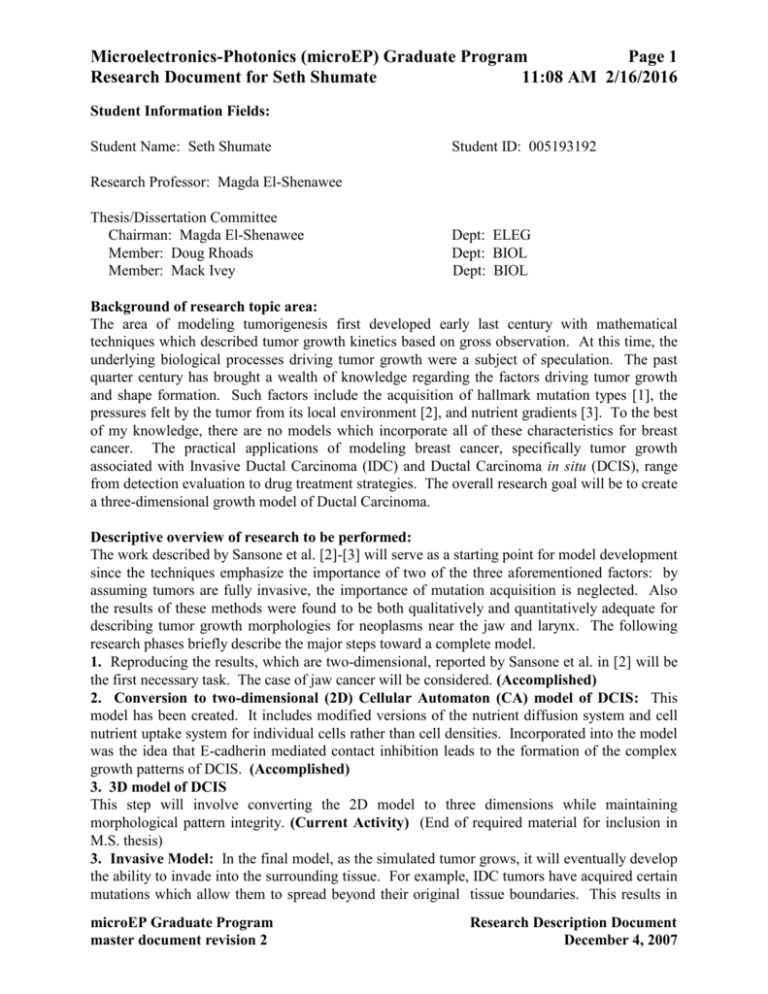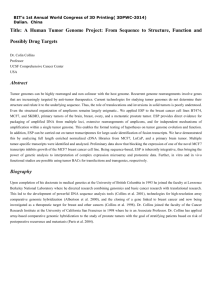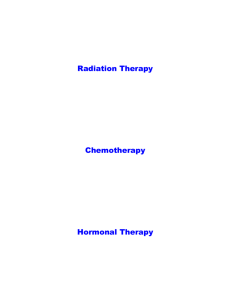Date - Microelectronics
advertisement

Microelectronics-Photonics (microEP) Graduate Program Page 1 Research Document for Seth Shumate 11:08 AM 2/16/2016 Student Information Fields: Student Name: Seth Shumate Student ID: 005193192 Research Professor: Magda El-Shenawee Thesis/Dissertation Committee Chairman: Magda El-Shenawee Member: Doug Rhoads Member: Mack Ivey Dept: ELEG Dept: BIOL Dept: BIOL Background of research topic area: The area of modeling tumorigenesis first developed early last century with mathematical techniques which described tumor growth kinetics based on gross observation. At this time, the underlying biological processes driving tumor growth were a subject of speculation. The past quarter century has brought a wealth of knowledge regarding the factors driving tumor growth and shape formation. Such factors include the acquisition of hallmark mutation types [1], the pressures felt by the tumor from its local environment [2], and nutrient gradients [3]. To the best of my knowledge, there are no models which incorporate all of these characteristics for breast cancer. The practical applications of modeling breast cancer, specifically tumor growth associated with Invasive Ductal Carcinoma (IDC) and Ductal Carcinoma in situ (DCIS), range from detection evaluation to drug treatment strategies. The overall research goal will be to create a three-dimensional growth model of Ductal Carcinoma. Descriptive overview of research to be performed: The work described by Sansone et al. [2]-[3] will serve as a starting point for model development since the techniques emphasize the importance of two of the three aforementioned factors: by assuming tumors are fully invasive, the importance of mutation acquisition is neglected. Also the results of these methods were found to be both qualitatively and quantitatively adequate for describing tumor growth morphologies for neoplasms near the jaw and larynx. The following research phases briefly describe the major steps toward a complete model. 1. Reproducing the results, which are two-dimensional, reported by Sansone et al. in [2] will be the first necessary task. The case of jaw cancer will be considered. (Accomplished) 2. Conversion to two-dimensional (2D) Cellular Automaton (CA) model of DCIS: This model has been created. It includes modified versions of the nutrient diffusion system and cell nutrient uptake system for individual cells rather than cell densities. Incorporated into the model was the idea that E-cadherin mediated contact inhibition leads to the formation of the complex growth patterns of DCIS. (Accomplished) 3. 3D model of DCIS This step will involve converting the 2D model to three dimensions while maintaining morphological pattern integrity. (Current Activity) (End of required material for inclusion in M.S. thesis) 3. Invasive Model: In the final model, as the simulated tumor grows, it will eventually develop the ability to invade into the surrounding tissue. For example, IDC tumors have acquired certain mutations which allow them to spread beyond their original tissue boundaries. This results in microEP Graduate Program master document revision 2 Research Description Document December 4, 2007 Microelectronics-Photonics (microEP) Graduate Program Page 2 Research Document for Seth Shumate 11:08 AM 2/16/2016 complex shapes that are markedly different than those associated with DCIS. This is due to the cancer cells’ interactions with a different types of tissues and cells. Recently, research into applying the hallmarks paradigm to breast cancer for treatment and diagnosis purposes was published [4]. 4. Inhomogeneous Tissue Environment: Cell functions such as mitosis, apoptosis, and motility will also depend on the availability of nutrients and the physical pressures from the surrounding tissues. As in the model from Sansone et al. [2], nutrient and oxygen gradients will be determined by the spatial distribution of blood supply present in and around the growing tumor. The ability of mutated cells to induce new blood vessel growth, angiogenesis, has been established as a necessary step for tumors to grow to detectable sizes [1]. The final model will take into account the characteristic vasculature of the mammary tissue regions of interest [5]. Quantification of proposed research boundaries (currently planned experimental space, including range of planned input variables and expected range of measured output): Simulation results will be compared with available clinical data for IDC and DCIS. The patterns for DCIS, along with the biological background supporting the simulation of those patterns, will help determine the behavior of the progression from in situ disease to invasive disease. Required results include completed models of DCIS in two and three dimensions. Listing of high-risk components of research effort: No high-risk components are foreseeable. Alternative research topic/output should some high-risk element cause a significant time delay to completion schedule: N/A Journal/Meeting(s) targeted for publication: IEEE Region 5 Conference (April, 2007) Arkansas Biosciences Institute Fall Symposium poster presentation (October, 2007) IEEE TBME Journal paper (December, 2007) ACES 2008 Conference (March 30-April 04, 2008) Progress made toward completion of research investigation: A successful model of ductal carcinoma in-situ of the breast was developed in two dimensions. This model relates the phenomena of changing E-cadherin expression with pattern formation within the duct. The model has been programmed for three dimensions and preliminary results have been obtained. [1] D. Hanahan, R.A. Weinberg, “The Hallmarks of Cancer,” Cell, vol. 100, pp. 57-70, 2000. [2] B.C. Sansone, P.P Delsanto, M. Magnano, M. Scalerandi, “Effects of anatomical constraints on tumor growth,” Phys. Rev. E, vol. 64, no. 2, pp. 021903-1-8, 2001. [3] M. Scalerandi, A. Romano, P. Pescarmona, P.P. Delsanto, C.A. Condat, “Nutrient competition as a determinant for cancer growth,” Phys. Rev. E, vol. 59, no. 2, pp. 2206-2217, 1999. [4] G.W. Sledge Jr., K.D. Miller, “Exploiting the hallmarks of cancer: the future conquest of microEP Graduate Program master document revision 2 Research Description Document December 4, 2007 Microelectronics-Photonics (microEP) Graduate Program Page 3 Research Document for Seth Shumate 11:08 AM 2/16/2016 breast cancer,” European Journal of Cancer, vol. 39, no. 12, pp. 1668-1675, 2003. [5] Gasparini, Giampietro, “Biological and clinical role of angiogenesis in breast cancer,” Breast Cancer Research and Treatment, vol. 36, no.2, pp. 103-107, 1995. microEP Graduate Program master document revision 2 Research Description Document December 4, 2007 Microelectronics-Photonics (microEP) Graduate Program Page 4 Research Document for Seth Shumate 11:08 AM 2/16/2016 The undersigned agree that this document describes the current status of the research investigation planned to meet microEP student Seth Shumate’s MS Thesis requirement for graduation. Any significant change in the overall scope of the investigation will be made only with the full review and agreement of the original signatories or their designee. microEP Student: ______________________________ Seth Shumate Date: __________ microEP Director: ______________________________ Ken Vickers Date: __________ Research Professor: (Chairman) ______________________________ Magda El-Shenawee Date: __________ Committee Member: ______________________________ Doug Rhoads Date: __________ Committee Member: ______________________________ Mack Ivey Date: __________ microEP Graduate Program master document revision 2 Research Description Document December 4, 2007





